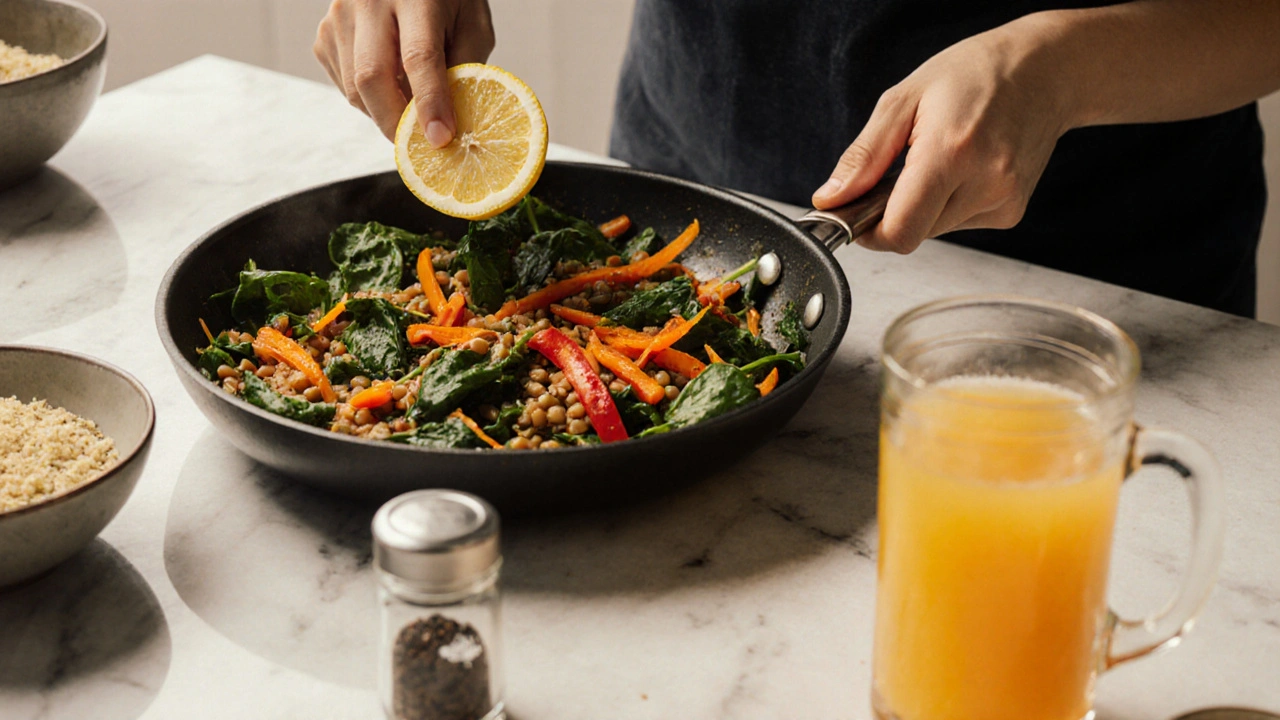If you’ve switched to a plant‑based diet, you already know the benefits—lower cholesterol, more fiber, and a smaller environmental footprint. But many newcomers wonder how to make sure they’re actually absorbing the nutrients they need. The good news is that a few everyday tricks can significantly improve how your body takes in iron, calcium, B12, omega‑3s and protein from plants.
Plants contain plenty of vitamins and minerals, yet some of them are bound to compounds that can block absorption. For example, phytic acid in beans and grains can tie up iron and zinc, while oxalates in spinach may limit calcium uptake. Understanding these interactions helps you plan meals that work with, not against, your gut.
1. Pair Iron‑Rich Foods with Vitamin C. Non‑heme iron from lentils, chickpeas and tofu is less readily absorbed than heme iron from meat. Adding a source of vitamin C—like bell peppers, citrus, or strawberries—right in the same meal can double the amount of iron your body pulls in. A lentil soup topped with a squeeze of lemon is a tasty example.
2. Soak, Sprout, or Ferment Grains and Legumes. Soaking beans for at least 8 hours, sprouting seeds, or fermenting dough breaks down phytic acid. The result is higher bioavailability of iron, zinc and calcium. Try sprouted hummus or fermented buckwheat porridge for a nutrient boost.
3. Choose Calcium‑Rich Plants with Low Oxalates. Kale, bok choy, broccoli and fortified plant milks provide calcium without the oxalate barrier that spinach presents. Pair these veggies with a little healthy fat—like olive oil or avocado—to improve calcium absorption.
4. Include Reliable B12 Sources. Vitamin B12 is not naturally abundant in plants. Fortified foods (nutritional yeast, plant milks, breakfast cereals) or a reliable B12 supplement are the safest ways to meet daily needs. Check the label for cyanocobalamin or methylcobalamin and aim for at least 2.4 µg per day.
5. Get Omega‑3s from ALA and Convert to EPA/DHA. Flaxseeds, chia seeds and walnuts deliver alpha‑linolenic acid (ALA). To help your body turn ALA into the longer‑chain EPA and DHA, include a source of dietary fat and avoid smoking, which can impede conversion. If you’re concerned about the conversion rate, consider an algae‑derived EPA/DHA supplement.
6. Eat Protein Throughout the Day. Plant proteins are often incomplete, missing one or more essential amino acids. By rotating sources—like beans, quinoa, nuts and soy—you’ll cover all the bases. A simple rule: aim for 20‑30 g of protein per meal, spread across 3‑4 meals.
7. Mind Your Gut Health. A healthy gut lining supports nutrient uptake. Include probiotic foods such as sauerkraut, kimchi or a daily serving of a plant‑based yogurt. Prebiotic fibers found in onions, garlic and chicory also feed good bacteria, further aiding absorption.
By applying these straightforward strategies, you can enjoy the full spectrum of nutrients a plant‑based diet offers. Remember, the goal isn’t to complicate meals, but to make small adjustments that pay off in energy, mood and long‑term health.
Ready to test a tip? Add a splash of orange juice to your morning oatmeal topped with almonds and chia seeds. You’ll boost iron absorption, get a dose of calcium and enjoy a tasty start to the day. Keep experimenting and listen to your body—your gut will thank you.

Learn practical ways to boost iron, B12, calcium, vitamin D and zinc absorption on vegetarian and vegan diets with food combos, cooking hacks, and gut‑health tips.

Finding the right online pharmacy can be vital when looking for affordable medication. Whether you're interested in more international options or simpler ordering processes, there are several alternatives to Canada Drugs Direct that may suit your needs better. This article explores these options, covering each one’s strengths and weaknesses, to help you make an informed choice.

This article dives into how online pharmacies handle privacy, secure packaging, and verification for erectile dysfunction medications. It covers the steps you can expect when ordering sensitive medications online and demystifies how discreet delivery works. You’ll get practical insights, tips, and real examples that help you shop for ED meds confidently. Whether you’re new to buying online or looking for safer ways to handle prescription privacy, this guide covers the details. Prepare to feel totally up-to-date on all things discreet in ED medication delivery.

Compare Penegra (sildenafil) with leading ED alternatives like Viagra, Cialis, Levitra, and Stendra. Learn differences in onset, duration, side effects, and price to find the right medication.

Benzodiazepines like Xanax and Valium may help with anxiety during pregnancy, but studies link them to increased risks of birth defects, miscarriage, and preterm birth. Learn what the latest research says and what alternatives exist.

Discover effective alternatives to Isotroin for acne treatment. This article explores natural hormonal treatments that offer a holistic approach, focusing on sustainability, fewer side effects, and addressing gut health and hormonal imbalances. Learn how dietary changes and stress management play crucial roles in these alternatives while considering the time and personalization needed for results. Get insight into how these options might fit your lifestyle.